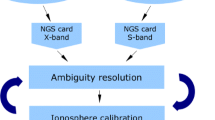Abstract
The earth’s phase of rotation, expressed as Universal Time UT1, is the most variable component of the earth’s rotation. Continuous monitoring of this quantity is realised through daily single-baseline VLBI observations which are interleaved with VLBI network observations. The accuracy of these single-baseline observations is established mainly through statistically determined standard deviations of the adjustment process although the results of these measurements are prone to systematic errors. The two major effects are caused by inaccuracies in the polar motion and nutation angles introduced as a priori values which propagate into the UT1 results. In this paper, we analyse the transfer of these components into UT1 depending on the two VLBI baselines being used for short duration UT1 monitoring. We develop transfer functions of the errors in polar motion and nutation into the UT1 estimates. Maximum values reach 30 [μs per milliarcsecond] which is quite large considering that observations of nutation offsets w.r.t. the state-of-the-art nutation model show deviations of as much as one milliarcsecond.
Similar content being viewed by others
References
Eubanks M, Archinal BA, Carter MS, Josties FJ, Matsakis DN, McCarthy DD (1994) Earth orientation results from US Naval Observatory VLBI program. IERS Technical Note 17, Observatoire de Paris R65–R79
Hefty J, Gontier A-M (1997) Sensitivity of UT1 determined single-baseline VLBI to atmospheric delay model, terrestrial and celestial reference frames. J Geod 71: 253–261
Heitz S (1976) Mathematische Modelle der geodätischen Astronomie; Deutsche Geodätische Kommission, Reihe A, No. 85, Verlag des Instituts für Angewandte Geodäsie, Frankfurt am Main
Herring TA (1996) The IERS 1996 theory of precession/nutation. In: McCarthy DD (ed.) IERS Conventions (1996), IERS Technical Note 21, Observatoire de Paris, pp 25–32
IVS (2007a) Analysis coordinator of the International VLBI Service for Geodesy and Astrometry, http://vlbi.geod.uni-bonn.de/IVS-AC/index.html (accessed 01.03.2007)
IVS (2007b) International VLBI service for geodesy and astrometry, products, http://ivscc.gsfc.nasa.gov (accessed 01.06.2007)
Ma C, Sauber JM, Bell LJ, Clark TA, Gordon D, Himwich WE (1990) Measurement of horizontal motions in Alaska using very long baseline interferometry. J Geophys Res 95: 21991–22011
Mathews PM, Herring TA, Buffet BA (2002) Modeling of nutation-precession: new nutation series for the non-rigid Earth, and insights into the Earth’s interior. J Geophys Res 107(B4), doi:10.1029/2001JB000390
Mueller I (1969) Spherical and practical astronomy as applied to geodesy. Frederick Ungar Publishing, New York
Ray JR, Carter WE, Robertson DS (1995) Assessment of the accuracy of IRIS Intensive daily UT1 determination. J Geophys Res 100(B5): 8193–8200
Robertson DS, Carter WE, Campbell J, Schuh H (1985) Daily Earth rotation determinations from IRIS very long baseline interferometry. Nature 316(6027): 424–427
Schlüter W, Behrend D (2007) The international VLBI service for geodesy and astrometry (IVS): current capabilities and future prospects. J Geod 81(6–8): 379–387, doi:10.1007/s00190-006-0131-z
Thaller D, Krügel M, Rothacher M, Tesmer V, Schmid R, Angermann D (2007) Combined Earth orientation parameters based on homogeneous and continuous VLBI and GPS data. J Geod 81(6–8): 529–541, doi:10.1007/s00190-006-0115-z
Titov O (2000) Influence of adopted nutation model on VLBI NEOS-intensives analysis. Proceedings of the IAU colloquium 180, Towards models and constants for sub-microarcsecond astrometry, 27–30 March 2000, US Naval Observatory, Washington, DC
Wahr JM (1981) The forced nutations of an elliptical, rotating, elastic and oceanless earth. Geophys J R Astron Soc 64: 705–727
Zhu S-Y, Mueller II (1983) Effects of adopting new precession, nutation and equinox corrections on the terrestrial reference frame. Bulletin Géodésique 57: 29–49
Author information
Authors and Affiliations
Corresponding author
Rights and permissions
About this article
Cite this article
Nothnagel, A., Schnell, D. The impact of errors in polar motion and nutation on UT1 determinations from VLBI Intensive observations. J Geod 82, 863–869 (2008). https://doi.org/10.1007/s00190-008-0212-2
Received:
Accepted:
Published:
Issue Date:
DOI: https://doi.org/10.1007/s00190-008-0212-2




